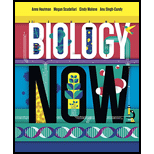
Concept explainers
In biology, the population growth is the increase in the number of individuals in a population. The growth of population can be limited by environmental factors, such as food shortages, predators, lack of space, weather, and habitat deterioration. The
Answer to Problem 1TQ
A group of interacting individuals of a single species located within a particular area is called as a population. Therefore, option (d) is correct.
Explanation of Solution
Justify the reasons for the correct statement:
The term population in biology refers to all the organisms of the single species or group which live in a particular geographical area and it has the capacity of interbreeding.
Option (d) is given as, “a population”.
Hence, the option (d) is correct.
Justify the reasons for the incorrect statements:
Option (a) is given as, “a biosphere”.
The worldwide sum of all ecosystems is called as biosphere and it is also known as ecosphere. It is the part of sea, land, and atmosphere in which organism is able to live. Thus, it does not contain a single species located within a particular area. Hence, it is a wrong answer.
Option (b) is given as, “an ecosystem”.
An ecosystem is a large community of living organisms which includes animals, plants, and microbes in a particular area. Thus, the ecosystem does not contain an organism of the single species or group. Hence, it is a wrong answer.
Option (c) is given as, “a community”.
An interacting group of two or more species lives in a common location in a particular interval of time is called as a community. Thus, the community also does not contain an organism of single species. Hence, it is a wrong answer.
Hence, options (a), (b), and (c) are incorrect.
Therefore, the number of living things or an organism that live in a particular area is known as a population.
Want to see more full solutions like this?
 Human Anatomy & Physiology (11th Edition)BiologyISBN:9780134580999Author:Elaine N. Marieb, Katja N. HoehnPublisher:PEARSON
Human Anatomy & Physiology (11th Edition)BiologyISBN:9780134580999Author:Elaine N. Marieb, Katja N. HoehnPublisher:PEARSON Biology 2eBiologyISBN:9781947172517Author:Matthew Douglas, Jung Choi, Mary Ann ClarkPublisher:OpenStax
Biology 2eBiologyISBN:9781947172517Author:Matthew Douglas, Jung Choi, Mary Ann ClarkPublisher:OpenStax Anatomy & PhysiologyBiologyISBN:9781259398629Author:McKinley, Michael P., O'loughlin, Valerie Dean, Bidle, Theresa StouterPublisher:Mcgraw Hill Education,
Anatomy & PhysiologyBiologyISBN:9781259398629Author:McKinley, Michael P., O'loughlin, Valerie Dean, Bidle, Theresa StouterPublisher:Mcgraw Hill Education, Molecular Biology of the Cell (Sixth Edition)BiologyISBN:9780815344322Author:Bruce Alberts, Alexander D. Johnson, Julian Lewis, David Morgan, Martin Raff, Keith Roberts, Peter WalterPublisher:W. W. Norton & Company
Molecular Biology of the Cell (Sixth Edition)BiologyISBN:9780815344322Author:Bruce Alberts, Alexander D. Johnson, Julian Lewis, David Morgan, Martin Raff, Keith Roberts, Peter WalterPublisher:W. W. Norton & Company Laboratory Manual For Human Anatomy & PhysiologyBiologyISBN:9781260159363Author:Martin, Terry R., Prentice-craver, CynthiaPublisher:McGraw-Hill Publishing Co.
Laboratory Manual For Human Anatomy & PhysiologyBiologyISBN:9781260159363Author:Martin, Terry R., Prentice-craver, CynthiaPublisher:McGraw-Hill Publishing Co. Inquiry Into Life (16th Edition)BiologyISBN:9781260231700Author:Sylvia S. Mader, Michael WindelspechtPublisher:McGraw Hill Education
Inquiry Into Life (16th Edition)BiologyISBN:9781260231700Author:Sylvia S. Mader, Michael WindelspechtPublisher:McGraw Hill Education





